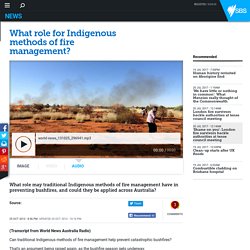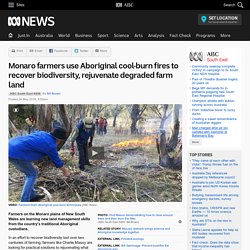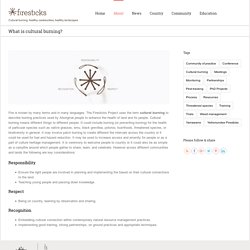

STIPA. Aboriginal fire management - Creative Spirits. Meaning of fire Fire is an important symbol in Aboriginal culture.

Traditionally it was used as a practical tool in hunting, cooking, warmth and managing the landscape. It also holds great spiritual meaning, with many stories, memories and dance being passed down around the fire. But when out-of-control bush fires burn Aboriginal land, they are "also burning up our memories, our sacred places, all the things which make us who we are," says Yuin woman Lorena Allam, because "[we] lose forever what connects you to a place in the landscape".
Whilst popularly known as traditional burning, cool burning, Indigenous burning, etc., the practice is actually cultural land management. — Bhiamie Eckford-Williamson, Euahlayi man and ANU researcher. Traditional Aboriginal burning - Parks and Wildlife Service. Details Published: 12 June 2013 Before Aboriginal people populated the Australian continent some 40,000 to 60,000 years ago, the major cause of fires would have been lightning.

Aboriginal people learnt to harness the naturally recurring fire caused by lightning and other sources to their advantage, which resulted in skilful burning of landscapes for many different purposes. Fire was used to: make access easier through thick and prickly vegetationmaintain a pattern of vegetation to encourage new growth and attract game for huntingencourage the development of useful food plants, for cooking, warmth, signalling and spiritual reasons.
Early European explorers and settlers commented on the Aboriginal people’s familiarity with fire, and the presence of fire in the landscape continually throughout the year. People - Alice Springs Desert Park. Werte!

Anwerne akangkeme anthurre arrantherre apetyeme Mparntwe Desert Park-werne. Apmere nhenhe Arrernte angkentye mape-kenhe. (Hello! We are very happy you have come to the Alice Springs Desert Park. This place belongs to the Arrernte language.) What role for Indigenous methods of fire management? (Transcript from World News Australia Radio) Can traditional Indigenous methods of fire management help prevent catastrophic bushfires?

That's an argument being raised again, as the bushfire season gets underway. But there those cautioning that while traditional methods may be useful in some areas, they can't be applied across Australia. Santilla Chingaipe has more. (Click on audio tab to listen to this item) Joe Morrison is the chief executive of the North Australian Indigenous Land and Sea Management Alliance.
Mr Morrison has told NITV, Indigenous people could play a role in reducing the risk of bushfires. "We know there's a disconnect between people actively managing fire right around the country and the ability to then suppress it later on. Mr Morrison says in the Northern Territory, controlled fires are used to harvest the land and to avoid major bushfires.
And he says these methods could be be used in other parts of the country. The Nature Conservancy. Supporting Indigenous people to manage their land for conservation.

For tens of thousands of years, Indigenous Australians managed the land. They hunted, gathered food, lit fires and fished in the ocean and rivers. Coming off the land after European settlement caused not only huge cultural and social dislocation and difficulty for Aboriginal Australians, it also proved a disaster for conservation. Problems caused by changes to fire regimes were compounded by the devastation caused by introduced species like cats, foxes and camels. A revolution is quietly occurring across Outback Australia, far from the eye of most Australians who live in urban areas. Monaro farmers use Aboriginal cool-burn fires to recover biodiversity, rejuvenate degraded farm land. Posted Media player: "Space" to play, "M" to mute, "left" and "right" to seek.

Video: Farmers learn Aboriginal cool-burn techniques (ABC News) Farmers on the Monaro plains of New South Wales are learning new land management skills from the country's traditional Aboriginal custodians. In an effort to recover biodiversity lost over two centuries of farming, farmers like Charlie Massy are looking for practical solutions to rejuvenating what he described as "severely degraded country". Dr Massy is a highly respected woolgrower, academic and author, and leader in a movement known as regenerative farming. "We just grazed the crap out of [the land] and destroyed it; what we're dealing with now is a degraded ecosystem," Dr Massy said. He said the use of chemicals and fertilisers to restore the landscape simply made the problem worse and suggested a better solution was to look to land management skills developed by the country's original custodians.
Firesticks – What is cultural burning? What is cultural burning?

Mitra2014-08-22T17:32:50+00:00 Fire is known by many terms and in many languages. The Firesticks Project uses the term cultural burning to describe burning practices used by Aboriginal people to enhance the health of land and its people. Cultural burning means different things to different people. It could include burning (or preventing burning) for the health of particular species such as native grasses, emu, black grevillea, potoroo, bushfoods, threatened species, or biodiversity in general. Responsibility Ensure the right people are involved in planning and implementing fire based on their cultural connections to the land.Teaching young people and passing down knowledge. Respect Being on country, learning by observation and sharing. Recognition Embedding cultural connection within contemporary natural resource management practices.Implementing good training, strong partnerships, on ground practices and appropriate techniques. Cool Burning - Primary - Cool Australia.
What's so cool about 'cool burning'?

In this learning unit, your students will investigate the way that Indigenous Australian land managers conduct controlled burns during the cool season of Australia's tropical savanna regions. These land managers are also sharing their knowledge with scientists so that everyone can care for C... Read more » What's so cool about 'cool burning'? In this learning unit, your students will investigate the way that Indigenous Australian land managers conduct controlled burns during the cool season of Australia's tropical savanna regions. In this exciting unit, we will explore and develop an understanding of new concepts, then use and consolidate that new knowledge to reach conclusions about cool burning. "What is wonderful about this curriculum is that it teaches the importance of Indigenous knowledge in land management which has existed throughout history and which continues today.